The Pollinator Study
go.ncsu.edu/readext?295876
en Español / em Português
El inglés es el idioma de control de esta página. En la medida en que haya algún conflicto entre la traducción al inglés y la traducción, el inglés prevalece.
Al hacer clic en el enlace de traducción se activa un servicio de traducción gratuito para convertir la página al español. Al igual que con cualquier traducción por Internet, la conversión no es sensible al contexto y puede que no traduzca el texto en su significado original. NC State Extension no garantiza la exactitud del texto traducido. Por favor, tenga en cuenta que algunas aplicaciones y/o servicios pueden no funcionar como se espera cuando se traducen.
Português
Inglês é o idioma de controle desta página. Na medida que haja algum conflito entre o texto original em Inglês e a tradução, o Inglês prevalece.
Ao clicar no link de tradução, um serviço gratuito de tradução será ativado para converter a página para o Português. Como em qualquer tradução pela internet, a conversão não é sensivel ao contexto e pode não ocorrer a tradução para o significado orginal. O serviço de Extensão da Carolina do Norte (NC State Extension) não garante a exatidão do texto traduzido. Por favor, observe que algumas funções ou serviços podem não funcionar como esperado após a tradução.
English
English is the controlling language of this page. To the extent there is any conflict between the English text and the translation, English controls.
Clicking on the translation link activates a free translation service to convert the page to Spanish. As with any Internet translation, the conversion is not context-sensitive and may not translate the text to its original meaning. NC State Extension does not guarantee the accuracy of the translated text. Please note that some applications and/or services may not function as expected when translated.
Collapse ▲Benefits of a Real Christmas Tree
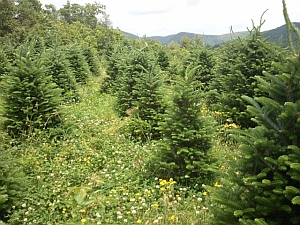 One of the virtues of using a real farm-grown Christmas tree is the benefits to the environment. In western North Carolina, Fraser fir Christmas tree growers maintain living ground covers around their trees. Growers do this for the many benefits to tree production such as lowering soil temperatures which allows for better root growth and nutrient up-take. But the environmental benefits are just as important. Learn more at: Weeds Are Out — Ground Covers Are In!
One of the virtues of using a real farm-grown Christmas tree is the benefits to the environment. In western North Carolina, Fraser fir Christmas tree growers maintain living ground covers around their trees. Growers do this for the many benefits to tree production such as lowering soil temperatures which allows for better root growth and nutrient up-take. But the environmental benefits are just as important. Learn more at: Weeds Are Out — Ground Covers Are In!
For every Fraser fir Christmas tree that is cut, there is typically 25 square feet of green space for wildlife, depending on tree spacing. Some of the most important wildlife are the smallest — the insects and particularly pollinators and insect predators — that are attracted to flowering ground covers. Though important through the growing season, these insects are not active in the late fall when trees are being cut and are not found on the cut Christmas trees that are marketed.
The Pollinator Study
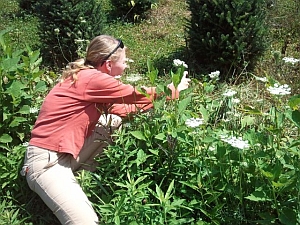 In 2012-2013, a study was conducted to determine the impact of ground covers on biodiversity, pollinators, and the natural enemies of Christmas tree pests. Pollinators aren’t important in the production of Christmas trees. Fraser fir are wind pollinated and Christmas trees are harvested at a young age before the tree is old enough to produce pollen. The ground covers which are maintained around trees as well as fields borders which grow up in weeds are very attractive to butterflies, bumble bees and honey bees. Pollinators aren’t the only insects of importance. Insect predators (insects that eat other insects) and parasitoids (insects that complete part of their life cycle inside of their insect host) are important in controlling many Fraser fir pests. Providing a suitable habitat for these in the field helps growers to continue to reduce pesticide use.
In 2012-2013, a study was conducted to determine the impact of ground covers on biodiversity, pollinators, and the natural enemies of Christmas tree pests. Pollinators aren’t important in the production of Christmas trees. Fraser fir are wind pollinated and Christmas trees are harvested at a young age before the tree is old enough to produce pollen. The ground covers which are maintained around trees as well as fields borders which grow up in weeds are very attractive to butterflies, bumble bees and honey bees. Pollinators aren’t the only insects of importance. Insect predators (insects that eat other insects) and parasitoids (insects that complete part of their life cycle inside of their insect host) are important in controlling many Fraser fir pests. Providing a suitable habitat for these in the field helps growers to continue to reduce pesticide use.
The pollinator study was conducted in 6 farms in 5 counties in western North Carolina. Growers used conventional growing practices. These fields were visited every two-to-three weeks from July through October 2012 and April through June 2013 for a total of 66 field observations. Learn more details on the Pollinator Study.
Fields of Flowers
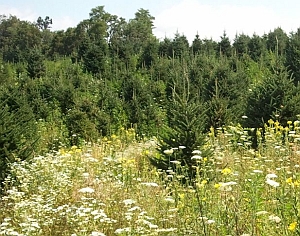 Have you ever heard the expression, you can’t see the forest for the trees? That might be true when you see a Christmas tree field. After all, what you see is row after row of trees that are sheared to look alike. It must be a monoculture. Nothing could be further from the truth.
Have you ever heard the expression, you can’t see the forest for the trees? That might be true when you see a Christmas tree field. After all, what you see is row after row of trees that are sheared to look alike. It must be a monoculture. Nothing could be further from the truth.
What’s important to the environment is what is growing around the trees and in field borders. The plants growing in ground covers were cataloged in the six Fraser fir Christmas tree farms as part of the pollinator study. With each visit, the species that were blooming and the percentage of the ground cover that made up that blooming plant were recorded. Observations of ground covers averaged over the 66 farm visits are as follows:
- 80+ species of plants in ground covers.
- Average of 38 species of plants at any given farm (the range was 30 to 48 different species of plants).
- Average of 7.2 species of flowers in bloom during study period.
- Average of 48% of ground cover blooming during study period.
Many of the ground covers like clover and goldenrod are important sources of pollen and nectar. Others, such as milkweed, are also important habitat for pollinators that are on the decline, such as Monarch butterflies.
Honey Bees, Bumble Bees, and Things that go Buzz
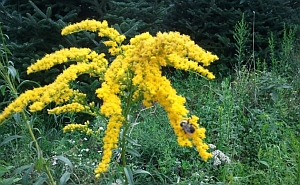
Honey bees, bumble bees, and other native pollinators are in decline in the US. When Christmas tree growers switched from killing all the ground covers around their trees to maintaining a living ground cover, people started noticing these returning to tree fields. Many predators of Fraser fir pests such as lacewings, lady beetles, and hover flies also depend on pollen and nectar sources at some point during their life cycle. Observations of pollinators and other beneficial insects average over the 66 farm visits are as follows.
- 17 genera of bees observed
- 69% of visits observed honey bees
- 61% of visits observed bumble bees
- 97 % of visits observed some type of bee
- 84 % of visits observed butterflies
- 62% of visits observed some type of predator important to Christmas tree pests
Learn more about bees in Christmas tree fields.
Learn more about butterflies in Christmas tree fields.
Learn more about predatory insects in Christmas tree fields.
How Growers Can Create Habitat for Pollinators
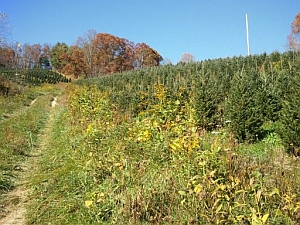 Christmas tree growers have the unique opportunity of creating habitat for pollinators as well as increasing the natural predators that give them free pest control. Managing field roads and borders for flowering weeds also greatly increases biodiversity in the field.
Christmas tree growers have the unique opportunity of creating habitat for pollinators as well as increasing the natural predators that give them free pest control. Managing field roads and borders for flowering weeds also greatly increases biodiversity in the field.
Learn how to create beneficial habitat and without letting weeds take over.
SPECIAL THANKS
North Carolina Cooperative Extension personnel involved in the study include:
- Jill Sidebottom, Area Extension Specialist for mountain conifer integrated pest management
- Meghan Baker, former Watauga County and current Buncombe County Agricultural Agent
- Travis Birdsell, Ashe County Agricultural Agent
- Brad Edwards, Area IPM Technician
- Teresa Herman, former Alleghany County and current Iredell County Extension Agent
- Jerry Moody, Avery County Extension Director
- Jeff Owen, Area Extension Christmas Tree Specialist
- Jeff Vance, Mitchell County Extension Director
Growers who are involved in the project include Bryan Davis, Wiley Gimlin, Ewing Harmon, Dan McKinney, Mike Shatley, and Jack Wiseman Jr.
Special thanks also to Dr. Logan Williams who identified bees to genus in this study.


